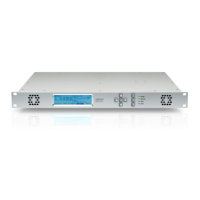RCS User Manual
32
Delete: Deletes the selected channel plan. Note: the active channel plan can not be deleted.
Export: Exports the selected channel plan to a .CSV file. The alarms profiles won’t be exported to
the .CSV file.
Import: Imports a channel plan from a previously created file using the Export function. Using the
Export and Import features, you can copy a channel plan from a RCS to another. The alarms
profiles won’t be exported to the file. The alarms profiles won’t be imported from the .CSV file.
All the channels of the selected plan are shown on the right side of the screen. To select a channel,
click on the button placed on the right of the channel.
Each channel has the following fields:
- Channel name: Up to 10 characters
- Destiny IP: Multicast/Unicast (for example 224.1.1.1)
- Port: Destination port
- Mode: RTP/UDP
- Source IP: The IP source of the Unicast traffic.
- Check source: If YES option is selected, only traffic from the source specified in the Source
IP field will be received. If you select YES, Source IP field must be filled.
- VLAN ID: Allows to select the VLAN ID. It also allows to add/change the VLAN list. This
feature will be explained later in this manual (see section VLAN Table Editor).
- Network IFACE: Selects the physical interface of the input traffic.
- T2-MI mode: if the RCS has the 902513 option,the user can enable the T2-MI mode in any
input.
- T2-MI PID: if the T2-MI mode is enabled, the user must indicate the PID packet which
conveys T2-MI packets. This PID usually is 0x1000, but it can be different.
- T2-MI Est. Tx Time: is the maximum expected transmission time. This parameter is used to
calculate the network delay measurement.
- IP: is the IP alarms profile assigned to the channel (*).
- ETR290: is the ETR290 alarms profile assigned to the channel (*).
- SERVICES: is the services alarms profile assigned to the channel (*).
- PID: is the PID Blacklist alarms profile assigned to the channel (*).
(*) For each channel of the plan, the user must select a profile for each type of alarm: IP, ETR290,
Services and PID. If the RCS has “user_selection” profiles (see section 1.3.1.- Alarms Profiles),
these are the profiles assigned by default to all the channels of the plan. If the RCS has not
“user_selection” profiles, then the profiles assigned by default are the “Factory default” ones.
You can also assign the factory default profiles to all the channels. To do that, please press the
“Restore Factory Default Profiles”.
If you want to assign the same profiles to all the channels, please press the “Bulk Configuration”
button.
Warning: It is not allowed to make changes on the active channel plan if the
polling mode is active

